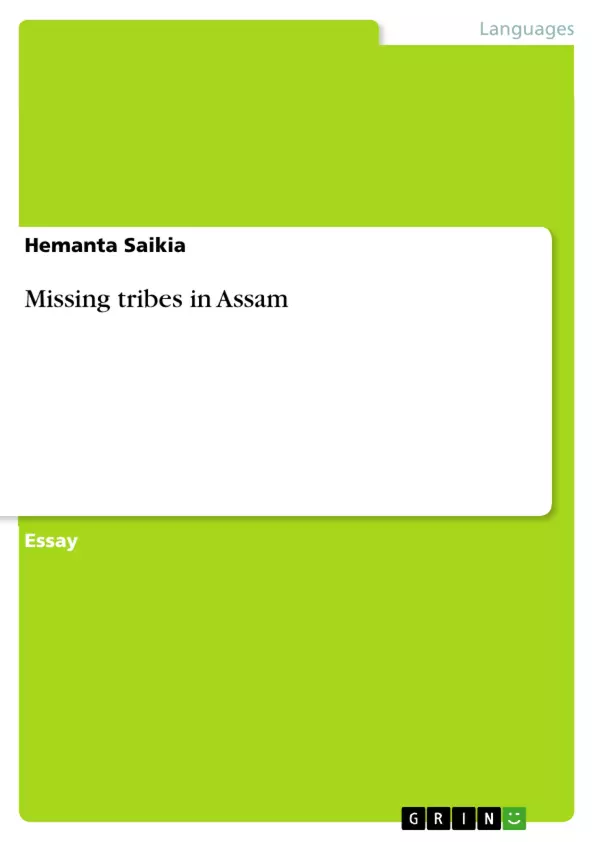The Mising is a major ethnic group of north east India and second largest tribe in Assam. As per 2001 census the Mising constitutes 17.8 percent of the tribal population of Assam and the total numbers of Mising population is 587,310. They are found mostly in Lakhimpur, Jorhat, Dibrugarh Dhemaji and Golaghat Districts of Assam. The Mising, being riverside people, have special liking to live on the riverbanks in spite of the fact that they have to face the flood of the river during the monsoon. Sometime flood force them to shift their villages. The Mising are still very backward and their socio-economic conditions have not developed. This essay attempts to explore the socio-economic condition of Mising people of Assam. Despite of the development of the socio economic structure of the Missing tribes, there is a gap still remains the socio economic development. Even though constitution provided a strong framework for the development of the Mising tribes they are still remain backward and so still strong foundation for the development of them is needed.
Table of Contents
- Introduction:
- Importance of the Study:
- Objectives of the Paper:
- Methodology of Study:
- Origin of the word ‘Miri' and ‘Mising':
- Findings of the Study:
- Social Status of Mising tribes:
- Education:
Objectives and Key Themes
This scientific essay aims to analyze the socioeconomic condition of the Mising people in Assam, a major ethnic group and the second largest tribe in the state. The study compares their socioeconomic situation with that of the general population in Assam, exploring the impact of modern practices on their lives.
- Socioeconomic conditions of the Mising people in Assam
- Comparison with the general population of Assam
- Impact of modern practices on Mising society
- Education and its role in social development
- The importance of socioeconomic development for the Mising community and Assam as a whole
Chapter Summaries
- Introduction: This chapter provides an overview of the diverse tribal population in Northeast India and highlights the socio-economic disparities between them. It introduces the Mising tribe, their geographical distribution, and their history of migration. The chapter concludes by emphasizing the need to explore the socioeconomic conditions of the Mising people.
- Importance of the Study: This chapter underscores the significance of studying the Mising tribe, highlighting their status as an indigenous group and the constitutional safeguards provided for tribal people in India. It emphasizes the need for regional development in Assam and the importance of the Mising people in achieving this goal.
- Objectives of the Paper: This chapter lays out the specific objectives of the study, which include analyzing the socioeconomic condition of the Mising people, comparing their situation with the general population of Assam, and assessing the impact of modern practices on their lives.
- Methodology of Study: This chapter explains the methodology employed in the study, which involves both primary and secondary data collection. The chapter details the use of both macro and microeconomic data and the selection of Golaghat district as the study site due to its significant Mising population. The chapter also outlines the multi-stage sampling method used for the primary data collection.
- Origin of the word ‘Miri' and ‘Mising': This chapter delves into the origin of the term "Miri," the name given to the Misings by the plains people of Assam. It discusses various theories regarding the origin of the word, focusing on its association with the Misings' role as mediators between Assam and the Abor tribes.
- Findings of the Study: This chapter delves into the social status of the Mising tribe, examining their social conditions, values, perceptions, and the impact of socio-economic development on their lives. It discusses various aspects of their social setting, including education, family size, livelihood, dress, food habits, religious outlook, and political awareness.
- Education: This chapter focuses on the importance of education for the Mising people, highlighting their interest in acquiring knowledge and skills. It discusses the literacy rates and educational attainment of the Mising population, comparing them to the national and state level.
Keywords
This scientific essay delves into the socioeconomic conditions of the Mising tribe in Assam, focusing on their social status, education, and the impact of modern practices on their lives. Key topics include tribal development, regional disparities, indigenous populations, socioeconomic indicators, and comparative analysis between the Mising people and the general population of Assam.
- Citar trabajo
- Dr. Hemanta Saikia (Autor), 2013, Missing tribes in Assam, Múnich, GRIN Verlag, https://www.grin.com/document/286521



